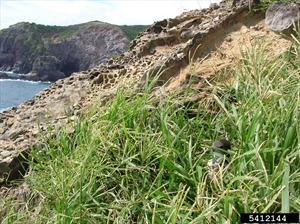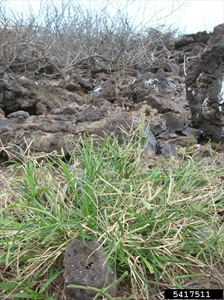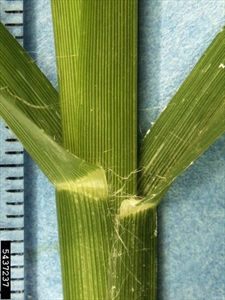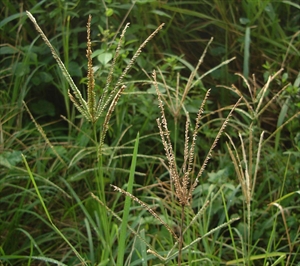Crowsfoot grass; it is also known as crow's foot, goosegrass, bullgrass, crabgrass, wire frass, and many more.
Pacific Pests, Pathogens, Weeds & Pesticides - Online edition
Pacific Pests, Pathogens, Weeds & Pesticides
Crowsfoot grass (461)
Eleusine indica. It is a member of the Poaceae.
Asia, Africa, North, South and Central America, the Caribbean, Europe, Oceania. It is recorded from Australia, American Samoa, Cook Islands, Federated States of Micronesia, Fiji, French Polynesia, Guam, Kiribati, Marshall Islands, Nauru, New Caledonia, New Zealand, Niue, Northern Mariana Islands, Palau, Papua New Guinea, Samoa, Solomon Islands, Tonga, Tuvalu, Vanuatu, and Wallis & Futuna.
It's exact origin is unknown, perhaps Africa and Asia. It is widespread and naturalised throughout the tropics and sub-tropics.
An important weed of agriculture and the environment that grows vigorously and produces a very large number of seeds. It invades cultivated and other disturbed locations as well as natural areas, such as the margins of natural forests and grasslands, marshes, streams and coastal areas (Photo 1). It is frequently seen along roadsides. Crowsfoot is found from seas level to 2000 masl.
Crowsfoot grows fairly flat to the ground, reaching to 40 cm high (Photo 2). The stems and the leaf sheaths are flattened. Leaves, flat to V-shaped (side folded in), up to 15 cm long and 8 mm wide, with boat-shaped tips; mostly the leaves are smooth, and bright green. The ligule - where the leaf sheaf and leaf blade meet - is short, 1 mm long, and has a few short hairs (Photo 3). Flowers, in spikelets attached closely along 3-8 central stems, each 5-10 cm long (Photo 4). One of these flower stems is usually attached 1 cm below the others (Photo 5). The seeds are reddish brown to black, about 1 mm long. Plants have a well-developed root system, difficult to pull from the ground.
Spread is by seeds. One plant can produce upwards of 50,000 seeds that can be dispersed by wind and water. Spread also occurs as a contaminant of seeds of other crops, in soil attached to machinery and vehicles, and on the fur of animals.
A weed with agricultural and environmental impacts. It is most serious in cotton, maize, upland rice, sweet potato and sugarcane. CABI quotes attempts to equate density of the grass with losses when growing with peanut and maize, concluding that reductions of 25 and 15%, respectively, were possible at the highest infestations measured. In separate work in India, it was found that removal of potassium is higher than all other weeds. Similarly, the grass caused substantial losses in upland rice in the Philippines and also Colombia. In Malaysia, infestations occurs in fruit and vegetable orchards, and nurseries and young oil palm plantations. Overall, it is estimated that in cotton and maize, the weed accounts for 1-2% of the 10-15% loss due to all weeds in these two crops, and this equates to many millions of dollars annually.
The plant is used as a medicine, food and source of materials for weaving mats and baskets, and making paper. The seed is small but is sometimes used as a famine food. It can be cooked whole or ground into a flour and used to make cakes and gruels. The seedlings are eaten too. In traditional medicine, it has many uses, from curing complaints of the bladder, relieving pain to stopping bleeding. It is sometimes used to stabilise soils.
AUTHORS Grahame Jackson & Aradhana Deesh
Adapted from Crowsfoot grass (Eleusine indica) (2018) Weeds of SE Qld and Northern NSW. Lucidcentral. (https://www.lucidcentral.org/editors-pick-animal-and-plant-identification-keys/key-to-weeds-of-se-qld-and-northern-nsw); and additional information from CABI (2019) Eleusine indica (goose grass). Invasive Species Compendium. (https://www.cabi.org/isc/datasheet/20675#toPictures); and from Eleusine indica (2014) Useful Tropical Plants. (http://tropical.theferns.info/viewtropical.php?id=Eleusine+indica). Photos 1&2 Forest and Kim Starr, Starr Environmental, Bugwood.org. Photos 3&4 Bruce Ackley, The Ohio State University, Bugwood.org. Photo 5. Tauʻolunga Eleusine indica, closeup (Wikipedia).
Produced with support from the Australian Centre for International Agricultural Research under project HORT/2016/185: Responding to emerging pest and disease threats to horticulture in the Pacific islands, implemented by the University of Queensland, in association with the Pacific Community and Koronivia Research Station, Ministry of Agriculture, Fiji.








